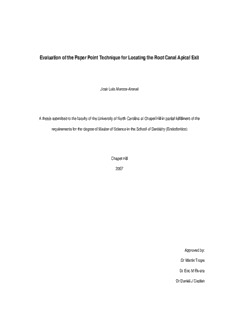Table Of ContentEvaluation of the Paper Point Technique for Locating the Root Canal Apical Exit
JoseLuisMarcos-Arenal
AthesissubmittedtothefacultyoftheUniversityofNorthCarolinaatChapelHillinpartialfulfillmentofthe
requirementsforthedegreeofMasterofScienceintheSchoolofDentistry(Endodontics)
ChapelHill
2007
Approvedby:
DrMartinTrope
DrEricMRivera
DrDanielJCaplan
ABSTRACT
JoseLuisMarcos-Arenal: EvaluationofthePaperPointTechniqueforLocatingtheRootCanalApicalExit
(underthedirectionofDrsMartinTrope,EricMRiveraandDanielJCaplan)
Anewmethodfordeterminingrootcanalworkinglength(WL),thepaperpointtechnique(PPT),hasbeen
claimedtobeaccurateandreproducible,buthasnotbeenformallyevaluated.
Hypothesis:WLdeterminationismoreaccuratewhentheElectronicApexLocatorTechnique(EALT)is
supplementedwithPPTcomparedtoEALTalone.
Thelengthsof84rootcanalsofunsalvageablehumanteethweremeasuredfirstusingEALT,thenPPT.
EndodonticfileswerecementedtothepositionindicatedbyPPT.TheteethwereextractedandmicroCT-
scanned.In71canalsthatprovidedadequatereadingsforbothEALTandPPT,theRCAEtofiletipdistance
wasmeasuredto20µmresolution.
Bothtechniquesshowed(1)moderateagreementand(2)excellentrepeatabilities.Therewas(3)asignificantly
greateraccuracyinlocatingtheRCAEwhenPPTwasusedcomparedtoEALTalone(p(cid:1)0.0051).
Conclusion:ItmaybeadvisabletosupplementtheEALTmeasurementwithPPT.
ii
dedicatedtothedentistsoftheFuture
iii
ACKNOWLEDGEMENTS
DrTrope,DrRiveraandDrCaplan,yousupportedmethroughoutthisprojectandwerepatientwithmy
innumerablequestions.
Everyoneofthepatientpatientswhoparticipatedinthestudy.
AndthestudentsandAdmissionsDeskstaff(Shirley†,Cynthia,MontyandJean)whoreferredthemtous.
WallaceAmbrosetaughtmehowtousethemicro-CTmachine.
Hyunsoon,LinandDrGKochfromtheUNCBiometricConsultingLaboratoryanalyzedourdataexpecting
nothinginreturn.
TheUNCDepartmentofEndodonticprovidedfundsandpremisesforthisproject.
Thank you.Iwillneverforgetit.
JLMA
iv
TABLEOFCONTENTS
LISTOFTABLES.........................................................................................................................................viii
LISTOFILLUSTRATIONS.............................................................................................................................ix
LISTOFABBREVIATIONS.............................................................................................................................x
CHAPTER1: INTRODUCTION................................................................................................................1
CHAPTER2: REVIEWOFTHELITERATURE........................................................................................3
2.1 APICALTHIRDOFAROOT.......................................................................................................3
2.1.1 AnatomyandHistology..................................................................................................3
2.1.1.1 Ofthetoothhardtissues........................................................................................3
2.1.1.2 Ofthetoothsofttissues:thedentalpulp...............................................................6
2.1.1.3 Oftheperiodontaltissuesurroundingtherootcanalexit.......................................7
2.1.2 Physiology&Pathology.................................................................................................7
2.2 WORKINGLENGTHDETERMINATIONINENDODONTICS.....................................................8
2.2.1 Definition........................................................................................................................8
2.2.2 TheimportanceofacorrectWLdetermination..............................................................8
2.2.2.1 Biologicalreasons.................................................................................................8
2.2.2.2 PhilosophicalReasons..........................................................................................9
2.2.3 TheapicalreferencepointinWLdetermination............................................................9
2.2.4 MethodstodetermineWL:description,degreeofaccuracyandshortcomings...........11
2.2.4.1 Periodontalsensitivity/Patientresponse..............................................................11
2.2.4.2 TactileMethod.....................................................................................................12
2.2.4.3 Radiographic.......................................................................................................12
2.2.4.4 Electronic.............................................................................................................16
2.2.4.5 CombineduseofEALandradiographs...............................................................20
2.2.4.6 Newmethod:thePaperPointTechnique............................................................20
2.3 MICROCOMPUTEDTOMOGRAPHY(CT)INEXPERIMENTALENDODONTICS..................22
2.3.1 Introduction..................................................................................................................22
2.3.2 Resolutionofmicro-CT(formeasurementofteethlength)..........................................22
2.3.3 Limitationsofmicro-CT................................................................................................23
v
CHAPTER3: MANUSCRIPT..................................................................................................................25
3.1 INTRODUCTION,LITERATUREREVIEWandRATIONALEforthisPROJECT......................25
3.2 HYPOTHESIS............................................................................................................................27
3.3 PURPOSEandSPECIFICAIMS...............................................................................................27
3.4 MATERIALSandMETHODS.....................................................................................................28
3.4.1 Overviewofdesign......................................................................................................28
3.4.2 SubjectsandTeeth......................................................................................................28
3.4.2.1 Inclusion/exclusioncriteria...................................................................................28
3.4.2.2 Collecteddata......................................................................................................29
3.4.2.3 Samplesizecalculation:......................................................................................29
3.4.3 Invivopartofthestudy:...............................................................................................30
3.4.3.1 Assessmentofpatientsandteeth........................................................................30
3.4.3.2 Anesthesia,operatingfieldisolationandtoothdecoronation...............................30
3.4.3.3 ObtainingtheEAL-length.....................................................................................31
3.4.3.4 ObtainingthePPT-length....................................................................................32
3.4.3.5 CementinganendodonticinstrumenttoPPT-length...........................................35
3.4.3.6 Toothextraction...................................................................................................35
3.4.4 Exvivopartofthestudy..............................................................................................35
3.4.4.1 Specimenpreparationandstorage......................................................................35
3.4.4.2 Micro-CTimageacquisition.................................................................................36
3.4.4.3 Volumetricreconstructionofthetoothapex.........................................................38
3.4.4.4 Analysisofreconstructedapices:measuringthefile-tiptoRCAEdistance.........38
3.4.4.5 ObservationsandMeasurements........................................................................39
3.4.5 DataAnalysis...............................................................................................................40
3.4.5.1 DefinitionofVariables..........................................................................................40
3.4.5.2 Analysisofthedata.............................................................................................40
3.4.5.3 ReliabilityoftheImageAnalysis..........................................................................41
3.5 RESULTS..................................................................................................................................42
3.5.1 Accuracy(n=71):.........................................................................................................43
3.5.2 Repeatability(n=9):.....................................................................................................46
3.5.3 Agreement(n=71):.......................................................................................................47
vi
3.6 DISCUSSION............................................................................................................................49
3.6.1 RegardingtheMaterialsandMethods.........................................................................49
3.6.2 RegardingtheResults.................................................................................................53
3.6.3 Researchquestionsforfutureprojects........................................................................61
3.6.4 ThePaperPointTechniqueinclinicalcontext.............................................................62
3.6.4.1 ImplementingthePPT.........................................................................................62
3.6.4.2 ExcessivelyshortPPTreadings..........................................................................63
3.7 CONCLUSIONS.........................................................................................................................64
APPENDIX A: RAWDATAoftheSTUDY...............................................................................................65
REFERENCES .........................................................................................................................................66
vii
LISTOFTABLES
Table1 (cid:1)InclusionCriteria 28
Table2 (cid:1)VariablesDataCollection 29
Table3 (cid:1)Sample 42
Table4 (cid:1)ContinuousAccuracyofEALTandEALT/PPT 43
Table5 (cid:1)CategoricalAccuracyofEALTandEALT/PPT(allintervalsobserved) 43
Table6 (cid:1)CategoricalAccuracyofEALTandEALT/PPT(RCAEascut-offpoint) 44
Table7 (cid:1)CategoricalAccuracyofEALTagainstEALT/PPT 44
Table8 (cid:1)CategoricalAccuracyofEALTandPPT(clinically-relevantranges) 45
Table9 (cid:1)Repeatedreadingsin9cases(rawdata). 46
Table10 (cid:1)Between-methoddisagreementwithinspecificranges 47
Table11 (cid:1) Criteriaforselectingtheapicallandmark 50
Table12 (cid:1)Criteriaforselectingatechniqueforanalyzingthespecimens’apices 53
Table13 (cid:1)Potentialerror-sourcestepsinEALTandPPT 60
Table14 (cid:1)TworootcanaltherapysequencesincorporatingthePPT 62
viii
LISTOFILLUSTRATIONS
Figure1.Rootapex:(A)horizontalcross-section.(B)longitudinalsection.Ppulp,Ddentin,Ccementum,AF
apicalperiodontalfibers,ABalveolarbone,Eepithelium,GRANgranulomatoustissue.FromSeltzer.........4
Figure2.Canalsforaminararelyareattherootapex.FromGutierrezandAguayo......................................7
Figure3.EndometricProbe.FromDummerandLewis................................................................................16
Figure4.PaperpointsshowingtheangleoftheRCAEtothelongaxisofthecanal.(A)FromRosenberg.(B)
FromWWatsonJr........................................................................................................................................20
Figure5.Studyteeth:isolatedanddecoronated..........................................................................................31
Figure6:Kerrabsorbentpaperpoints..........................................................................................................33
Figure7.Representationofapaperpointrightat(A)andpast(B)theRCAE.............................................34
Figure8.TOP:Lengthofthelongestpaperpointreturningcompletelydry..................................................34
Figure9.Teethlabeledandstoredinformalhaldehyde................................................................................36
Figure10.Specimenswereplacedinplasticvialspriortomicro-CTscanningprocess...............................37
Figure11.A:SkyScanmicro-CTunitusedinthisproject. B:Plasticvialcontainingspecimen,positionedon
rotatingstand................................................................................................................................................37
Figure12.Analysisofcross-sections:(A)theonetoshowthelastevidenceofthefiletip,(B)thelastoneto
showtherootcanalasafulloval..................................................................................................................39
Figure13.Parametricanalysisofbetween-methodagreement:pairedmeanreadinglengthsagainstpaired
differenceofreadings...................................................................................................................................48
Figure14.RepeatabilityanalysisoftheEALTandPPT(in9cases): meanagainststandarddeviation.....55
ix
LISTOFABBREVIATIONS
3D (cid:1) threedimensional
2D (cid:1) twodimensional
AC (cid:1) ApicalConstriction
AF (cid:1) ApicalForamen
CDJ (cid:1) CementoDentinalJunction
CT (cid:1) ComputedTomography
(cid:2) (cid:1) Meanpairederrordifferenceofthemeasurements
EAL (cid:1) ElectronicApexLocator
EALT (cid:1) ElectronicApexLocatorTechnique
EALT-accuracy (cid:1) distancefromEALT-lengthtotheRCAE
EALT-length (cid:1) lengthofthecanalaccordingtotheEALT
IRB (cid:1) InstitutionalReviewBoard(alsoEthicalReviewBoard)
PPT (cid:1) PaperPointTechnique
PPT-accuracy (cid:1) distancefromPPT-lengthtotheRCAE
PPT-length (cid:1) lengthofthecanalaccordingtothePPT
RA (cid:1) RadiographicApex(oftherootofatooth)
RCAE (cid:1) RootCanalApicalExit
S (cid:1) within-subjectstandarddeviationofeachparticulartechnique
w
S (cid:1) standarddeviationofthebetween-methodpaireddifferences
d
UNC-CH (cid:1) UniversityofNorthCarolinaatChapelHill
WL (cid:1) WorkingLength
x
Description:Jose Luis Marcos-Arenal: Evaluation of the Paper Point Technique for adequate readings for both EALT and PPT, the RCAE to file tip distance in this apex/periapex region is where the pulpal tissue gradually turns into Non-clinical landmarks are the apical constriction, apical foramen and

